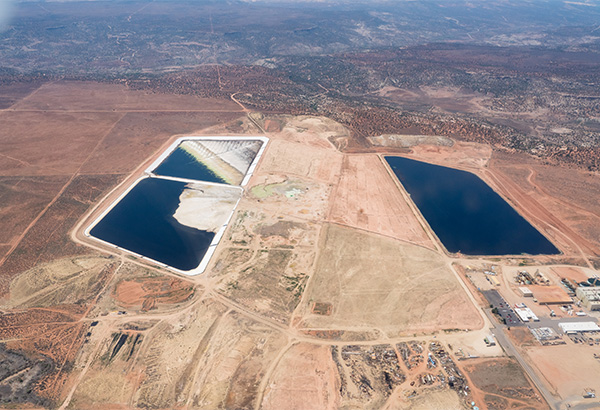FOR IMMEDIATE RELEASE
New Report and Story Maps Detail Radioactive Waste Threat Near Bears Ears
WHITE MESA, UT — A new Grand Canyon Trust research report and interactive story map collection released today detail how the White Mesa uranium mill, a mile from Bears Ears National Monument, has become America’s cheapest radioactive waste dump.
The report, “The Business of Radioactive Waste,” and accompanying map series, “Bears Ears & Radioactive Waste: The White Mesa Mill Story,” chronicle more than 15 radioactive waste streams approved for shipment to the U.S.’s last functioning uranium mill, which neighbors the Ute Mountain Ute Tribe’s White Mesa community.
The report found that over 700 million pounds of these wastes — including remnants of the Manhattan Project and waste considered too toxic for disposal at the Nevada Test Site — have been buried in the mill’s waste pits. The mill plans to bury millions more from as far away as Estonia and Japan.
“They are bringing in uranium wastes the mill is not equipped to handle safely,” Chairman Manuel Heart of the Ute Mountain Ute Tribe told reporters in 2017. “Our concern from the Ute Mountain Ute Tribe is how do we protect our tribal members...from radioactive waste that’s two and a half or three miles from them? How do we protect them?” Chairman Heart said in a press conference today.
READ THE REPORT: The Business of Radioactive Waste: a high-stakes game of hot potato ›
In August 2021, the Ute Mountain Ute Tribe passed a Tribal Council resolution stating that “…the operations of the White Mesa Mill has had severe health impacts on the residents of White Mesa and should cease entirely…”
In December 2021, the U.S. Environmental Protection Agency barred the mill from accepting waste from federal Superfund sites over concerns related to emissions of cancer-causing radon gas, but the order does not halt other radioactive waste shipments.
“As the uranium market shifts amid the transition away from fossil fuels, two years of COVID disruption, and the attack on Ukraine, the White Mesa Mill must stand as a cautionary tale for decision-makers of how domestic mineral production is not, by its very nature, a boon. We have much work to do to genuinely ensure social and environmental justice in America’s energy transition,” said Grand Canyon Trust Energy Director Amber Reimondo.
Licensed in 1980 to process uranium ore, including from mines in the Grand Canyon region, the White Mesa Mill has transformed its business model to instead operate as a waste-disposal service. According to the report, the mill has earned as much as $5-15 million per year to process and discard other industrial and military facilities’ radioactive wastes.
“Polluters are finding that the cheapest place to send unwanted radioactive waste is the White Mesa Mill — but it’s not a waste dump, it’s a uranium mill,” said Cultural Landscapes Director Tim Peterson. “If the White Mesa Mill wants to act like a radioactive waste dump, it should be regulated like one.”
Download maps and photos (free for media use) ›
The report also reveals how the White Mesa Mill’s radioactive waste business compounds the environmental injustices of the uranium industry, transferring the burden of wastes that have threatened tribal communities on the Spokane Indian Reservation, the Cherokee Nation, and elsewhere, to the White Mesa Ute community.
“Our water quality is really doomed when we have operations like the White Mesa Mill….We’re very tied to our land," said Regina Lopez-Whiteskunk, former member of the Ute Mountain Ute Tribal Council and former co-chair of the Bears Ears Inter-Tribal Coalition. "We’re very tied to our culture. It’s our identity. It’s very important that we protect every aspect of our natural resources, our air and our water.”
“Uranium and the mill represent environmental injustice that continues to be endured by the county’s Indigenous and low-income populations,” said Commissioner Kenneth Maryboy of the San Juan County Commission. “The White Mesa uranium mill would not be allowed to operate near a wealthy white neighborhood in Salt Lake City, and San Juan County's Native American communities deserve nothing less. Every Labor Day, White Mesa has a Bear Dance that many of my community members participate in, and you can smell the cloud that comes from the mill. I’m concerned about that pollution getting into the groundwater and migrating down to the San Juan River.”
“For Native peoples our tribal homelands have been targeted and exploited by the uranium industry. The burden of safeguarding radioactive and toxic waste is a forever problem. Our communities cannot heal if we are perpetually being poisoned and our rights to clean air, water, and land are being violated. The nuclear burden that so many frontline communities have carried has unfortunately shifted to the White Mesa Ute Mountain Ute community, within one of Native America’s most sacred landscapes, Bears Ears,” said Cultural Landscapes Manager Talia Boyd.
Find maps, timelines, and primary sources in the interactive story map collection, "Bears Ears and Radioactive Waste: The White Mesa Mill Story" ›
View in Full Screen (suggested for mobile)



